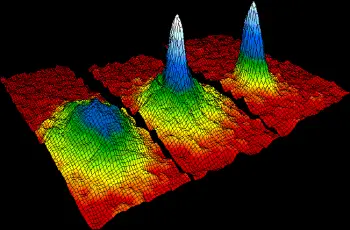
Quantum physics leads us to explore the strange and wonderful properties of matter in extreme states.
One of the most notable achievements in this field is the Bose-Einstein condensate (BBE), a state of matter that occurs at temperatures close to absolute zero, in which particles behave collectively and display surprising quantum properties. .
In this article, we will explain in detail what CBE is, how it is formed and its applications in current physics.
What is Bose-Einstein condensate?
The Bose-Einstein condensate (BBE) is a state of matter that is obtained at extremely low temperatures, close to absolute zero (-273.15°C or 0 Kelvin).
In this state, the particles, called bosons, collapse into the lowest energy quantum state, forming a single macrostate. This means that all particles in the condensate occupy the same quantum state and behave as a single collective entity.
To understand this, we first need to understand some key characteristics of bosons and their relationship to quantum statistics. Unlike fermions, which follow the Pauli exclusion principle and cannot occupy the same quantum state at the same time, bosons can share a quantum state without restrictions. This allows a large number of them to clump together into a single quantum state, creating the CBE.
Formation of Bose-Einstein condensate
The formation of CBE is a process that involves cooling atoms to extremely low temperatures. There are several ways to achieve this, but a common technique is laser and evaporative cooling.
In laser cooling, laser beams are used to slow down atoms, which decreases their kinetic energy and therefore their temperature. Evaporative cooling involves trapping atoms in a magnetic trap and then allowing them to slowly escape, removing the most energetic atoms and ultimately cooling the sample.
As the temperature decreases, the bosons clump together in the lowest energy state, forming the CBE. This phase transition is a manifestation of quantum statistics and is described by the Bose-Einstein wave function.
Properties of Bose-Einstein condensate
Bose-Einstein condensate exhibits a number of notable properties:
-
Phase coherence: All particles share the same phase of their wave function, allowing them to act as coherent waves.
-
Condensation: As they cool, a significant number of bosons accumulate in the lowest energy state, forming condensate.
-
Quantum interference: Due to phase coherence, Bose-Einstein condensates can show quantum interference patterns, similar to those observed in double-slit experiments with particles.
-
Superfluidity: CBEs also exhibit superfluidity, meaning they can flow frictionlessly through solid containers, as if they had no viscosity.
-
Anomalous sound dispersion: The speed of sound in a CBE is slower than expected, which is due to interactions between particles in this condensed state.
Applications in current physics
 The Bose-Einstein condensate has significant implications in various fields of physics and science. Some of the areas where it has been used or is being investigated for use include:
The Bose-Einstein condensate has significant implications in various fields of physics and science. Some of the areas where it has been used or is being investigated for use include:
-
High-precision metrology: This state of matter has been used in ultra-precise atomic clocks and in the definition of measurement units, such as the second and the kelvin, allowing extremely precise measurements.
-
Quantum computing: Bose-Einstein condensates are highly coherent systems, making them promising candidates for storing and processing quantum information in the context of quantum computing.
-
Condensed matter studies: CBE has been used to investigate condensed matter phenomena, such as superfluidity and exciton condensation in semiconductors.
-
Quantum simulations: CBEs can be used to simulate complex quantum systems and study phenomena that would be difficult to analyze otherwise.
-
Fundamental research: CBEs are also used in research into fundamental questions in physics, such as dark matter and phase transitions in quantum systems.
Conclusion
The Bose-Einstein condensate is one of the most intriguing and promising achievements in quantum physics. This state of matter, which forms at temperatures close to absolute zero, offers a window into a world of surprising quantum behaviors.
Its applications range from high-precision metrology to quantum computing and fundamental research.
The CBE is a testament to the ability of quantum physics to reveal new phenomena and revolutionize our understanding of the universe at microscopic scales.
